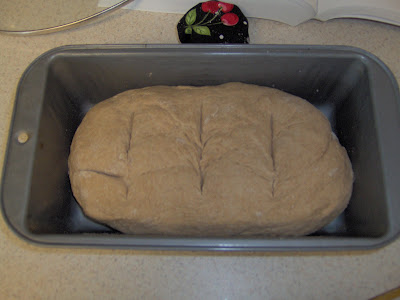Makes 1 large loaf or 2 to 3 small loaves.
2 2/3c. Sourdough Starter (which I will list at the end of this post.)
4 1/4c. freshly ground spelt, kamut, or hard winter wheat
1t. coarse sea salt
1/2c. cold filtered water
Traditional sourdough bread, prepared with a started rather then with yeast, has a delicious flavor but tends to be heavy for modern tastes. Spelt gives the most satisfactory loaf.
Your starter should be at room temp. and have gone through the bubblng, frothy stage.
Place starter, salt and water in a large bowl and mix with a wooden spoon until the salt crystals have dissolved. Slowly mix in the flour.
Towards the end you will find it easier to mix with your hands. You my add a few more tablespoons of water if the dough becomes too thick. It should be rather soft and easy to work with. Knead by pull and folding over, right in the bowl, for 10 to 15 minutes; or knead in batches in your food processor.
Without pressing down on the dough, cut or shape loaves into desired shapes or place into a large well buttered loaf pan.
Cut a few slits in the top of the dough, cover & let rise from 4 to 12 hours, depending on the temperature.
Bake at 350 degrees for about an hour. Allow to cool before slicing. The bread will keep for up to a week without refrigeration.
Voila!
Sourdough Starter from Nourishing Traditions
Makes about 3 quarts
2c. freshly ground rye flour
2c. cold filtered water
cheesecloth
6c. freshly ground rye flour
cold filtered water
Best results for sourdough started are obtained from rye rather then wheat flour, perhaps because rye contains a lower phytate content then wheat. You will need two gallon-sized bowls. Total time to make starter is one week.
Grind 2 cups flour and let it sit for a bit to cool. In one large bowl, mix flour with 2 cups of cold water. The mixture should be quite soupy. Cover with a double layer of cheesecloth secured with a rubber band---this will allow yeasts and bacteria to get in but will keep insects out. In warm weather, you may set the bowl outside in the shade if you live in an unpopulated are and no pesticides have been used in your garden. Otherwise keep it in a warm open area indoors or on a patio.
The next day and every day for a total of 7 days, transfer the started to another clean bowl and add 1 cup freshly ground rye flour plus enough could water to make a soupy mixture. (in my experience this is about 3/4c.) Cover and let stand. After a few days the started will begin to bubble and develop a wine like aroma. It should go through a bubble, frothy stage and then subside. After 7 days, the started is ready for breadmaking. Use as much as needed to make your bread and save at least 1 quart for your next batch of starter. If not using remaining starter immediately, you may store it in airtight jars in the fridge or freezer. (I suggest the fridge.)
Do not be tempted to add honey to your starter, as some recipes require. Honey encourages the proliferation of yeasts at the expense of lactic-acid producing bacteria and may give you an alcoholic fermentation. To make a new batch of starter, place the quart of leftover starter in a clean bowl. Add 1 cup freshly ground rye flour plus water each day, changing bowls until 3 quarts are obtained.











No comments:
Post a Comment